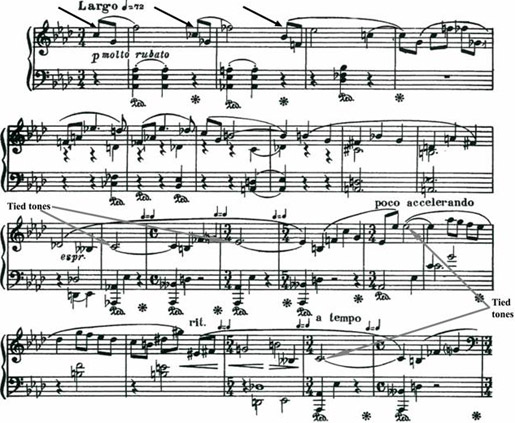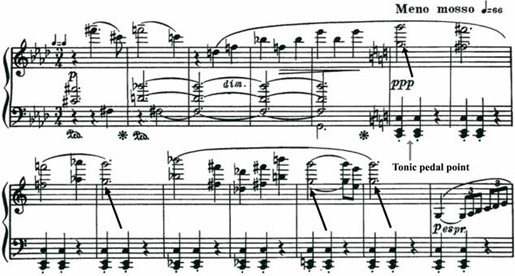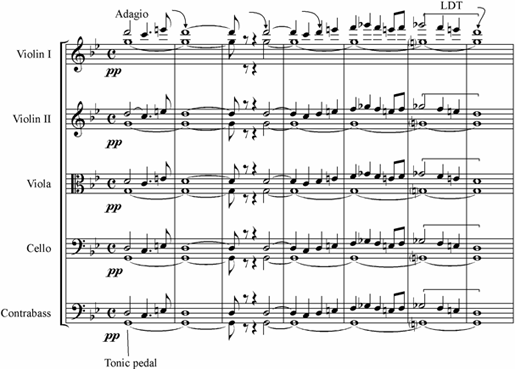Shostakovich's Piano Sonata No. 2 (cont'd)
The Second Movement (Largo)
The second movement of the Sonata is a three-part structure with a modified recapitulation (A – B – A1). In a similar manner to the first movement, chromatic mediant tonal relationships (Ab Major – C Major – Ab Major) are used in the second.
a) The main theme—‘fragility effect’
The main theme of the second movement is a perfect example of Shostakovich’s melodic style of the period. As with many of Beethoven’s themes, Shostakovich’s themes in the Sonata are primarily built from short motives – ‘seeds’ which grow into phrases and periods. The ‘seed’ of the first theme of the second movement is a three-note motive consisting of Shostakovich’s favourite intervals – the fourth and seventh (perfect fourth down and minor seventh up); this creates a broken melodic line (contour), another typical characteristic of Shostakovich’s melodies. Shostakovich was never considered a great melodist (nor, in fact, was Beethoven!), but many of his melodies (primarily in slow movements or the lyrical second subjects of the sonata forms) deeply impress, almost mesmerise with their extreme tenderness, fragility and delicacy (hereinafter referred to as the fragility effect).
The fragility effect of the main theme is created by the combination of broken melodic contours, dissonant unstable and unresolved harmonies, and soft dynamics. See Example 10. It is important to note that the introductory three-note motive is immediately followed by the sequential development (similar to the introductory semiquaver phrase of the first movement, but with an unusual half-tone step), the chromatic structure of which adds to the fragility effect of the main theme. Another factor that significantly contributes to the fragility effect is a freedom of meter: the beginning of the theme is marked molto rubato. Starting from bar 13, the meter changes in almost every bar. In the first section, the initial 3/4 changes to C (common time), then 5/4; in the recapitulation (Section A1) - 2/4 and even 1/4 (!) are used.
Example 10. Second Movement. The First Theme (A).
Fragility effect: broken melodic contour, wide intervals, slow tempo, molto rubato (Black arrows show the three-note motive— a model and the two transpositions of a sequence, grey arrows show the tied tonic tones—the thirds and the fifths)

The structure of the main theme of the second movement is another example of the use of polyphonic methods of thematic development that create an effect of an ‘endless’, relentless unfolding process. Shostakovich creates this effect by a) avoiding full cadences (with the tonic in root position); b) the use of the tied third and fifth tones of the tonic triad as melodic links between neighbouring bars that normally provide closure, but instead here appear to be an indication of further development [in Example 10, bars 12 (tied C), 14 (tied Eb), 16 (tied Eb), 21 (tied C). See arrows]. Thus, the composer turns the whole A section into one ceaseless 44-bar episode that flows directly into the middle section (again, a clear similarity to the primary thematic sections of the first movement of the Sonata).
b) The Middle Section: ‘mesmerising effect’
Episode B (bars 45–76, the middle section in C Major) is one of Shostakovich’s most recognizable musical images – it ‘mesmerises’ the listener in a different way (hereinafter referred to as the mesmerising effect). (See Example 11, Meno mosso.)
Example 11. Second Movement, the Middle Section (B) (Meno mosso).
Mesmerising effect: the 'pivotal' type of melody, the tonic pedal point, slow tempo,
distant registers, soft dynamics; arrows show the returning G (dominant in C Major)

Regarding the intervallic structure of the melody in section B, there is little contrast with the main theme (the same easily recognisable broken interval line - steps with fourths ascending and descending). The major difference between the first and the second themes, which contributes to the mesmerising effect, is the melodic contour of the theme: the G2 recurs three times in the first phrase of this melody, accompanied by the tonic pedal point (a ‘pivotal’ type of the melodic contour). It is interesting to note that the ‘dominant-oriented’ melody complements the tonic triad (there is no G in the ostinato tonic chords in the accompaniment layer). Another important characteristic contributing to the mesmerising effect is the rarefied texture, which, analogously to the secondary theme or the second development of the first movement, is created by using the distant registers of the keyboard (four and a half octaves between the bottom C and the top G). The extremely slow tempo completes the set of stylistic features contributing to the mesmerising effect.
It is important to note that the structure of the middle section is a parallel 33-bar period consisting of regular 8-bar phrases, 4-bar semi-phrases, etc. (the extra bar is created by an extension at the end of a period). A closed periodic structure is used for the second time in the Sonata, and is, again, associated with the ‘evil’ image (the first time it was used to shape the ‘invasion’ episode of the first movement).
Among later works, a perfect example of the mesmerising effect is the introduction to the first movement of the Eleventh Symphony (Year 1905, 1957) - the prominent image of ‘The Palace Square’ in revolutionary St. Petersburg. See Example 12.22
Example 12. The Eleventh Symphony, First Movement ('The Palace Square').
Mesmerising effect: the 'pivotal' type of melody, the tonic pedal point, distant registers, slow tempo, soft dynamics. Arrows show the returning D (dominant G minor). Bracketed is the downward 'LDT' (created by the Dorian mode) transposed the fifth up.

c) Recapitulation (A1)
Shostakovich would probably have accused himself of ‘self-betrayal’ had he simply repeated the main theme ‘untouched’ in the recapitulation (A1). The first section is transformed by the composer’s favourite method of motivic development - contrapuntal imitations of the main motive in different textural layers. In this episode, Shostakovich applies a perfect canon: the exact same melody starts in the soprano part and then repeats in the tenor part one quarter beat later. The canon is supported by tonic chords in the bass – a typical example of Shostakovich’s three-storey polyphonic texture. (Interestingly, the tonic chords in the home key [Ab Major] come before the actual change of key indicated by the key signature.) See Example 13.
In the recapitulation, the fragility effect of the main theme is further enhanced by the use of very soft quick passages (demisemiquavers, with very soft [ppp] dynamics) before each main note; they actually function as extended melismas. Taking into consideration that all the passages are performed with pedalling, this entire episode can be perceived as a truly impressionistic picture (hereinafter referred to as the pictorial effect) where the image gradually dissolves and becomes almost invisible. Semantically, the real image (‘self’) in the first section, after facing its possible ‘fate’ (the middle section), becomes a reminiscence or a dream and gradually fades away in the final section. The fragile lyrical image created in the first theme obviously belongs to the ‘self’ group of images of the Sonata – this is actually a ‘self-portrait’ of the composer, one-of-a-kind among his works (comparable to a self-portrait in the visual arts).
Example 13. Second Movement, Recapitulation.
Arrows show the entrances of a canon.

» Next: The Third Movement (Theme and Variations)
« Previous: First Movement (Moderato)-Modified Sonata Form
Footnotes
22 When comparing the two images composed 14 years apart, the similarities in the stylistic means are amazing. To my knowledge, the Sonata is the first significant work where this very ‘Shostakovich’ image was so clearly introduced.
